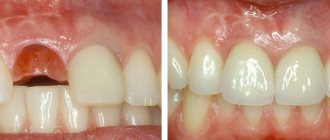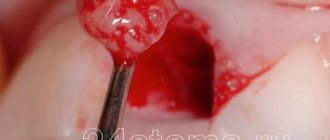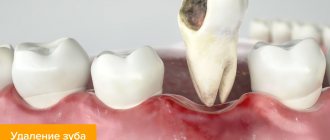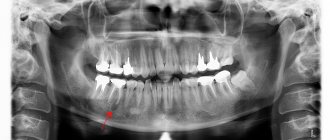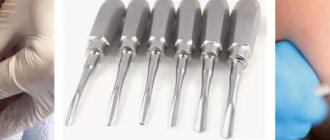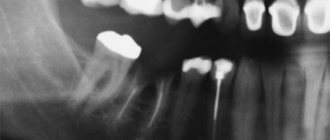Preservation of the hole - a necessity or a new trend?
Preservation of the socket - filling the cavity formed after tooth extraction with osteogenic material - is a very important component of dental treatment after tooth extraction.
This technique completely prevents bone resorption, which is known to be 25% already in the first year, which means that within 3 years the loss of bone volume can be 60%.
Preservation of the socket not only stops this process, but also preserves the gingival contour without gaps and prepares the gingival bone for future unhindered implant installation.
It is important that conservation ensures the correct load on the bone tissue, which means that at the time of implantation the condition of the bone will be exactly what is necessary for installing the implant without prior bone grafting.
Thus, preserving the socket after tooth extraction will not only save the patient from additional bone-building surgery, but will also save a considerable amount, because bone grafting is not the cheapest dental operation.
this is the paradox...
... that there are very few clear manuals, recommendations and described experience in the conservation of holes. The authors are content with either drawings or not entirely convincing “before” and “after” photographs, from which it is not clear whether the tooth socket healed “on its own” or such healing is a consequence of the conservation procedure.
In other words, in theory everyone knows how and why this is done. I am sure that most doctors are fine with their practice, but very few colleagues are able to clearly demonstrate their own experience. Therefore, in fact, I had to master everything on my own, simultaneously making mistakes and complicating my own work. But who said that implantology and surgery are easy?
If implantation is not planned, is socket preservation necessary?
If implantation is not planned, preservation of the hole will still be the right decision. This simple procedure will, at a minimum, speed up the healing process of the hole and completely prevent all sorts of risks of complications and infection, and at most - taking into account the fact that you should never say “never” - it will be very useful when you need to install an implant. In other words, this is a real opportunity to give the patient choice.
Preservation of the socket after tooth extraction is recommended for anyone who needs to install an implant in place of a missing tooth. This procedure will help preserve the volume of jaw bone and the natural contours of the alveolar process, and subsequently avoid alveolar bone augmentation for implantation.
There are practically no contraindications
except for acute pain. But even in this case, everything is individual, taking into account medical indications corresponding to the specific clinical situation.
Advantages of socket preservation after tooth extraction
- Minimum healing time for a socket after tooth extraction.
- Preventing infection from entering the socket.
- Preservation of bone tissue.
- The aesthetic appearance of the gingival contour is a guarantee of aesthetic prosthetics.
- Possibility to install an implant 1 month after tooth extraction.
- No need for augmentation.
The advantages of the procedure are obvious, which is why preservation of the socket after tooth extraction is very popular in dental dentistry.
100% guarantee of successful surgery - high-quality osteoplastic materials.
Materials for hole preservation Genoss (South Korea)
— the best bone replacement materials for socket preservation today.
Where does it all begin?
And it all starts with a low-traumatic tooth extraction.
And this is the real problem. Neither patients nor some doctors consider this an important procedure, although proper tooth extraction could save a lot of effort and money during further implantation.
Let's reformulate the problem of the delete operation. Let us designate it not as “ tooth removal at any cost ,” but as “ tooth removal with maximum preservation of surrounding tissue .” Even in case of acute pain. Because if a tooth is literally ripped out with half of the alveolar ridge, no subsequent preservation will help avoid osteoplasty.
Therefore, sometimes low-traumatic tooth extraction takes a long time and requires more than just working with forceps:
then
In general, friends, by spending a little more time and effort on tooth extraction, you can seriously make your future implant treatment easier.
Genoss bone replacement materials
Genoss are bone substitutes of the highest quality, which have been successfully used in dentistry for a very long time.
When are Genoss osteoplastic materials used?
Genoss have proven themselves to be excellent in filling sockets at the site of an extracted tooth, dental implantation, bone ridge plastic surgery, filling cystic hilar cavities, in the case of post-osteotomy techniques, in restoring periodontal tissues, and filling cavities during sinus lifting.
Benefits of Genoss
- One hundred percent biocompatibility with tissues of the human body.
- High resorbability.
- Rapid tissue healing.
- Improvement of hemostasis.
- Easy to use.
In what cases is tooth extraction necessary?
Our specialists always strive to preserve the teeth of their patients. Removal is carried out only in the following cases:
- Tooth fracture
.
- Difficulties with wisdom teeth
. Removal is necessary if wisdom teeth shift and deform the dentition, damage the soft tissues of the cheeks during chewing and interfere with a full life in general.
- Deformation of the dentition
. If there is an incorrect bite and if there is deformation of the dentition, the removal of interfering teeth is recommended on the recommendation of an orthodontist.
- The occurrence of dental diseases
. These include purulent periostitis, sinusitis of the maxillary sinuses, etc.
- If it is not possible to carry out prosthetics and install a crown
.
In some situations, resorting to such a radical treatment method is not recommended. This procedure should not be carried out in case of exacerbation of mental illnesses and chronic heart diseases. Contraindications are also certain periods of pregnancy and infectious diseases in the acute phase. In these cases, visiting the dental office should be postponed.
Make an appointment
Contraindications
Preservation surgery is subject to the same restrictions as any osteoplastic surgery. Separately, I would like to note that it is not recommended to preserve a hole after tooth extraction in a state of acute pain, since the risk of complications increases. But in each specific clinical case, the actions of a professional dentist are strictly individual. Sometimes situations arise when you have to take risks, but this is due solely to medical indications. In any case, it is necessary to understand that performing a tooth extraction operation and subsequent preservation on a planned basis is better than as part of emergency care.
Hole preservation procedure
Preservation of the socket of an extracted tooth is a fairly simple and effective operation for preserving bone volume and maximizing the preservation of the natural contours of the alveolar socket. This surgical procedure is performed under local anesthesia and does not pose any risk.
Usually the operation is carried out in several stages:
- treatment of the hole after tooth extraction with special antiseptic compounds;
- installation of a membrane to protect the vestibular wall;
- filling the socket cavity with granular bone-forming substance;
- fixation of the operating surface by tensioning the free edges of the connective tissue;
- applying a bandage or a thin, neat suture.
Complete healing of the postoperative area occurs by the fourth week, and after 3–4 months, in some cases 6 months, if the condition is satisfactory, this area can be used to install an implant.
Treatment quality criteria
The main criterion for the quality of an alveolar socket preservation operation is its independent complete healing and maximum preservation of bone tissue, preservation of the natural contour and volume of the alveolar ridge, improvement of the condition of soft tissues and simplification of further stages of treatment. If the operation is successful, there will be enough bone tissue in the socket to install a dental implant. Separately, it is worth highlighting the advantages of condomization for the doctor and the patient - this is improved long-term treatment results, more predictable aesthetics and, of course, saving time for the doctor and the patient.
Restrictions
It is logical to perform a preservation operation after the removal of permanent molars, within the so-called sevens, second molars (except for wisdom teeth, eights), since when baby teeth fall out, bone tissue does not resorption. There is no upper age limit for performing an operation aimed at preserving the natural contours of the alveolar process.
Types of seams
There are generally two types of suture materials used by dentists. The difference between them is that one type “resolves” (dissolves), the other does not.
Seams that dissolve
Slit stitches (absorbent stitches) have the advantage that they do not need to be removed. Your body breaks them down and gets rid of them. Such sutures will easily dissolve without damaging the gums. Doctors often use these stitches, as they say: why injure the wound by removing stitches if they can disappear on their own. These types of sutures are sometimes called "catgut" sutures or simply "gut" sutures.
How long does it take for them to dissolve? The time taken for disintegration depends on the type of material. Intestinal sutures remain intact for 5-7 days, chronic treatment lasts about 9-14 days. Some synthetic materials can last for a couple of weeks.
How long does it take for threads to dissolve?
Special threads for suturing are very convenient, since when using them there is no need to further injure the surgical site. But not all patients know how long they need to wait for the process of thread resorption to complete.
As a rule, if high-quality suture material is used, not a trace will remain of it within 20–30 days after the operation.
It should be noted that the threads simply fall apart, and then the person unnoticed swallows them. There is no discomfort or danger if thread residues enter the stomach.
Proper oral care after removal.
It is important to follow your dentist's advice regarding oral care after the extraction procedure. Your doctor will explain to you in detail how to prevent pain, discomfort and inflammation. After recovery, you can contact us for implantation and prosthetics. Our qualified dentists will help restore the beauty and naturalness of your smile using the most modern prosthetic methods.
Tooth extraction RUB 3,500.
Tooth extraction (complicated) RUB 5,000.
Tooth extraction with bone grafting RUB 15,000.
Removal of an impacted tooth RUB 15,000.
Curettage of tooth socket RUB 1,000.
Resection of the root apex 10,000 rub.
Increasing the anatomical length of a tooth RUB 10,000.
Excision of the hood (pericoronitis) RUB 3,000.
Lip frenuloplasty RUB 3,000.
Tongue frenuloplasty RUB 2,500.
Gum correction with laser RUB 2,500.
Laser gum retraction (1 tooth) 500 rub.
Treatment of alveolitis (curettage, drug treatment) RUB 1,500.
Open curettage (1 tooth) 1500 rub.
Opening an abscess 2000 rub.
Anatomy of the alveolar process
The alveolar, or dental, process (from Latin - processus alveolaris) is the part of the upper and lower jaws that extends from their bodies and contains teeth. The development and normal functioning of this structure is ensured by the roots of the teeth located in it. The alveolar process appears only after teeth erupt and almost completely disappears with their loss. After a tooth is removed, the corresponding area undergoes resorption (resorption). Dental alveoli, or sockets, are individual cells of the alveolar process in which teeth are located. They are separated from each other by bony interdental (interalveolar) partitions. Inside the alveoli of multi-rooted teeth there are also internal (intra-alveolar) interradicular septa, which extend from the bottom of the alveoli and divide the alveoli into chambers (according to the number of roots). The alveolar socket of the tooth has clear, defined boundaries, and it has all the conditions for bone regeneration; you just need to help it maintain its contour.

